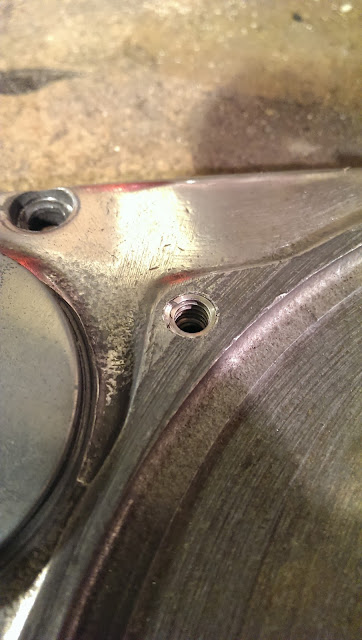As the CX edges closer to being rideable again, I have lost my daily ride - the SQ4 clutch is making a strange shrieking rattle that sounds like a loose centre so I am bikeless at the moment.
On the upside, the CX has its radiator filled - I have replaced the O rings I chewed up on the coolant pipe:
I've also discovered that Cillit Bang makes a great cleaner for the old Japanese Aluminium - look at the rear engine cover above the starter, and the coolant pipe clamps:
Coming back to the radiator, the captive nuts that Honda used to retain the front radiator grille to the shroud are knackered, rusty, and cost £4.50 each. I have these rubber M5 expanding nuts from eBay which fit the 9.5 mm holes beautifully (with a smear of silicone grease)
Here's one
I've discarded the original M5 screws and replaced them with stainless cap heads & washers. In this mock up, you can see how they expand the rubber nut to retain the front grille:
I've shined up the grille with a smear of silicone grease:
Moving forward, the calipers have been removed to have their Helicoils fitted:
I've also fitted the front wheel to get it out of the way while I wait for the Helicoils to come:
That's all for now - hopefully I can repair the calipers later this week.
On the upside, the CX has its radiator filled - I have replaced the O rings I chewed up on the coolant pipe:
I've also discovered that Cillit Bang makes a great cleaner for the old Japanese Aluminium - look at the rear engine cover above the starter, and the coolant pipe clamps:
Coming back to the radiator, the captive nuts that Honda used to retain the front radiator grille to the shroud are knackered, rusty, and cost £4.50 each. I have these rubber M5 expanding nuts from eBay which fit the 9.5 mm holes beautifully (with a smear of silicone grease)
Here's one
I've discarded the original M5 screws and replaced them with stainless cap heads & washers. In this mock up, you can see how they expand the rubber nut to retain the front grille:
I've shined up the grille with a smear of silicone grease:
Moving forward, the calipers have been removed to have their Helicoils fitted:
I've also fitted the front wheel to get it out of the way while I wait for the Helicoils to come:




















































